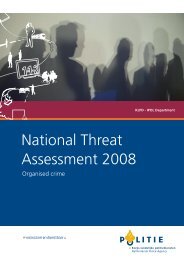Assessing the Effectiveness of Organized Crime Control Strategies ...
Assessing the Effectiveness of Organized Crime Control Strategies ...
Assessing the Effectiveness of Organized Crime Control Strategies ...
You also want an ePaper? Increase the reach of your titles
YUMPU automatically turns print PDFs into web optimized ePapers that Google loves.
<strong>Assessing</strong> <strong>the</strong> <strong>Effectiveness</strong> <strong>of</strong> <strong>Organized</strong> <strong>Crime</strong> <strong>Control</strong> <strong>Strategies</strong>:<br />
A Review <strong>of</strong> <strong>the</strong> Literature<br />
<strong>the</strong> early 1980s “spawned at least two dozen o<strong>the</strong>r criminal networks in <strong>the</strong> same neighbourhood<br />
as replacements for <strong>the</strong> crime group that had been targeted.”<br />
Lyman and Potter (1997) attribute <strong>the</strong> poor outcomes <strong>of</strong> headhunting strategies to<br />
misunderstandings about <strong>the</strong> workings <strong>of</strong> OC. They note that crime syndicates have learned to<br />
adapt <strong>the</strong>ir structures and practices in <strong>the</strong> form <strong>of</strong> decentralization and relationships that are more<br />
short-term. As headhunting disables just a small proportion <strong>of</strong> OC entrepreneurs at any given<br />
time, it may actually streng<strong>the</strong>n some groups by weeding out <strong>the</strong>ir inefficient competitors.<br />
Ano<strong>the</strong>r shortcoming <strong>of</strong> <strong>the</strong> headhunting strategy is that <strong>the</strong>y <strong>of</strong>ten target easier cases involving<br />
highly visible, but not necessarily influential, crime figures. Targeting high-pr<strong>of</strong>ile gangsters<br />
who are relatively easy to convict makes for good press, but will yield little in terms <strong>of</strong> impact.<br />
Lyman and Potter (1997:436) contend that, “It is <strong>the</strong> relative immunity <strong>of</strong> major figures in<br />
organized crime, such as corrupt <strong>of</strong>ficials, money launderers, and o<strong>the</strong>rs who serve as bridges<br />
between <strong>the</strong> underworld and <strong>the</strong> upper world that so clearly demonstrates <strong>the</strong> deficiencies in <strong>the</strong><br />
headhunting strategy.”<br />
4.3 Prosecutions Through <strong>the</strong> Use <strong>of</strong> Taxation Laws<br />
Citizens have obligations as taxpayers to file tax returns, make truthful declarations, and<br />
maintain complete business records. When income cannot be accounted for, whe<strong>the</strong>r connected<br />
to illicit acts or o<strong>the</strong>rwise, recourse exists in <strong>the</strong> form <strong>of</strong> prosecutions for failing to report it. The<br />
Internal Revenue Service in <strong>the</strong> United States, for example, employs special agents who are<br />
charged with ga<strong>the</strong>ring evidence <strong>of</strong> criminal violations for prosecution by <strong>the</strong> Department <strong>of</strong><br />
Justice.<br />
Tax-related fraud can be established via direct and indirect methods (Abadinsky, 2003:313). The<br />
direct method involves <strong>the</strong> identification <strong>of</strong> unreported taxable receipts, overstated costs and<br />
expenses, and improper claims for credit or exemption. The advantage <strong>of</strong> this method is that <strong>the</strong><br />
evidence is easier for jurors to understand.<br />
OC figures, however, tend to avoid a paper trail—dealing in cash and maintaining few records—<br />
or set up legitimate businesses as fronts to conceal <strong>the</strong> illicit sources <strong>of</strong> <strong>the</strong>ir income. One<br />
indirect method <strong>of</strong> ascertaining <strong>the</strong>ir income is <strong>the</strong> net-worth method. Using this approach, a<br />
taxpayer’s net worth is established as precisely as possible at <strong>the</strong> beginning <strong>of</strong> <strong>the</strong> taxation<br />
period. This amount is <strong>the</strong>n subtracted from his or her net worth at <strong>the</strong> end <strong>of</strong> that taxation<br />
period. The net gain is considered <strong>the</strong> taxpayer’s income, which is <strong>the</strong>n compared with <strong>the</strong><br />
income declared for that period. The government does not need to show a probable source <strong>of</strong><br />
<strong>the</strong> gain in net worth that is unreported. O<strong>the</strong>r indirect methods compare expenditures and bank<br />
deposits with reported income (Albanese, 1996:170).<br />
The most celebrated target <strong>of</strong> this type <strong>of</strong> financial investigation was Al Capone. He could not<br />
account for over $100,000 <strong>of</strong> expenditures a year through legitimate income and was ultimately<br />
convicted for failing to pay taxes on $1 million <strong>of</strong> illegal income (Albanese, 1996:171). From<br />
1960 to 1965, over half <strong>of</strong> all convictions <strong>of</strong> OC leaders in <strong>the</strong> United States stemmed from tax<br />
investigations (Rhodes, 1984).<br />
22 | Research and Statistics Division / Department <strong>of</strong> Justice Canada








